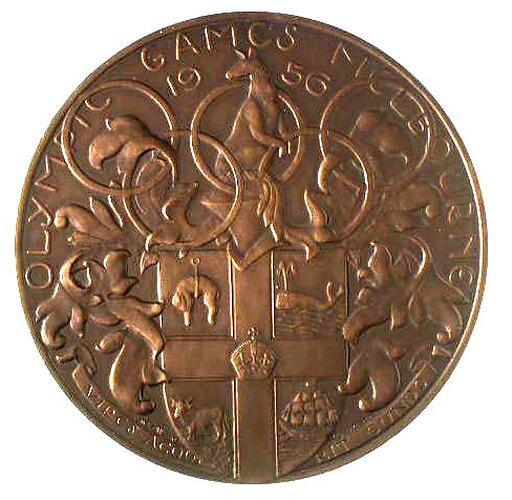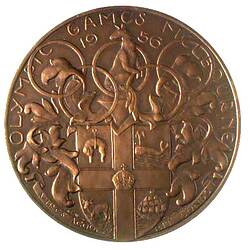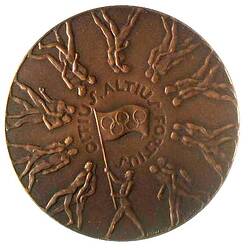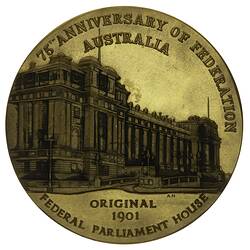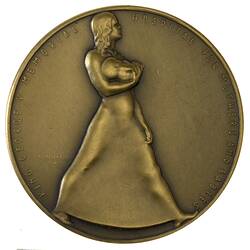Summary
Bronze medal struck for distribution to participants of Melbourne Olympic Games. Designed by Andor Mészáros; the dies were made in London by Pinches and minted in Australia by K.G. Luke, 1956.
The 1956 Olympics were a major sporting, cultural and social event for Australia and for Melbourne in particular. This medal, with the arms of Melbourne surmounted by Olympic rings and a kangaroo, was presented to participants in the Games, including athletes, officials and trainers. It was designed by medallist Andor Mészáros, a Hungarian immigrant. Although he had been living and working in Australia since 1939, it was through his Olympic medal design that he received widespread official approval and established public awareness of his work.
The Melbourne Games were the first Olympics to have a cultural component, and Andor was responsible for organising a sculpture exhibition in connection with the Games. In a ceremony at the Melbourne Town Hall, he received an award for his efforts: a medal of his own design.
Physical Description
Bronze medal, 63mm diameter, featuring arms of Melbourne surmounted by Olympic rings and Kangaroo. The reverse features athletes marching in pairs around rim, except for one who holds Olympic flag at centre. Flag in centre.
Obverse Description
Arms of Melbourne surmounted by Olympic rings and Kangaroo; around above, OLYMPIC GAMES MELBOURNE / 1956
Reverse Description
Athletes marching in pairs around rim except for one who holds Olympic flag at centre; around flag, CITIUS . ALTIUS . FORTIUS
Edge Description
Plain
Significance
For over half a century, sculptors Andor (1900-1973) and Michael (1945- ) Meszaros have created medals that reflect the high points of life in Australia. From major awards and portraits of eminent Australians to artwork celebrating popular culture and the natural world, these objects illuminate our culture and history. Grounded in a centuries-old European art tradition, the medals create connections across disciplines and link such diverse subjects as scientific advances, religious themes, sport, the performing arts and motherhood. Through their public and private commissions and their personal artworks, the Meszaros sculptors have defined the modern Australian medal.
More Information
-
Collection Names
1956 Melbourne Olympic Games Collection, Mészáros Medals Collection
-
Collecting Areas
Numismatics & Philately, Public Life & Institutions, Migration & Cultural Diversity
-
Acquisition Information
Transfer from National Gallery of Victoria (NGV), 15 Mar 1976
-
Date Issued
1956 AD
-
Issued By
1956 Melbourne Olympic Games Committee, Melbourne, Greater Melbourne, Victoria, Australia, 1956
-
Mint
K. G. Luke (Mint), 1956
12,500 of these medals were struck. -
Artist
-
Inscriptions
Obverse: around above, 'OLYMPIC GAMES MELBOURNE / 1956'. Reverse: around flag, 'CITIUS . ALTIUS . FORTIUS.'
-
Series
-
Material
Copper
-
Axis
12
-
Classification
-
Category
-
Discipline
-
Type of item
-
Exhibition Collection Management
5 mm (Depth), 63 mm (Outside Diameter)
-
Maximum dimensions
63 mm (Width), 4 mm (Depth)
Measurement From Conservation.
-
Shape
Round
-
References
Carlisle (1983), reference # 1956/
[Catalogue] Sharples, John P. 1990. Medals as Art: Australia and the Meszaros Tradition.
[Article] Jewell, Ray T. 1986. Michael Meszaros: The Man and his Medals. Journal of the Numismatic Association of Australia. 2: 4-24.
[Book] Carlisle, Leslie J. 1983. Australian commemorative medals and medalets from 1788.
-
Keywords
Medals, Olympic Games: Melbourne, 1956, Sporting Awards, Sporting Competitions
